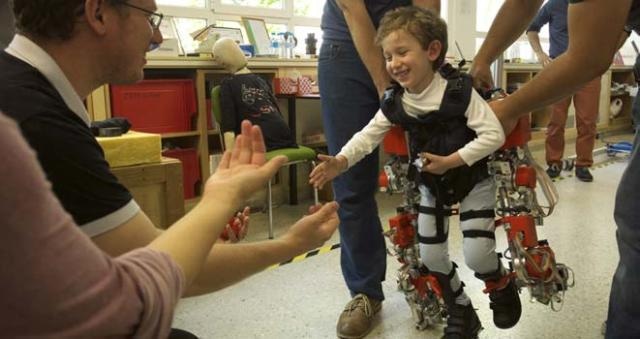Jun 9 2016
The world’s first pediatric exoskeleton specifically designed for children suffering from spinal muscular atrophy has been introduced by the Superior Council for Scientific Research (CSIC). Spinal muscular atrophy is a degenerative disease that affects 1 out of 10,000 babies in Spain.
 Five-year-old Álvaro, who suffers from spinal muscular atrophy, walks towards his parents during an exoskeleton test. (Credit: Joan Costa - CSIC)
Five-year-old Álvaro, who suffers from spinal muscular atrophy, walks towards his parents during an exoskeleton test. (Credit: Joan Costa - CSIC)
The device is constructed using aluminum and titanium. It weighs 12kgs and is designed to assist patients to walk in certain cases for the first time. In addition, the exoskeleton will also be utilized in hospital-based physiotherapy to eliminate the loss of agility in this disease. This technology, which is presently in the preclinical phase, has been jointly licensed and patented by the CSIC and Marsi Bionics, a technology-based business unit of CSIC.
The brace contains long support rods, referred to as orthoses, which are adapted to accommodate around the child’s legs and trunk. A set of motors in the joints imitate the human muscles and provides the child the required strength to stand up and walk. The system also includes a series of sensors, a motion controller, and a battery having 5h of life.
The number one drawback in developing this type of paediatric exoskeleton is that the symptoms of neuromuscular illnesses- such as spinal muscular atrophy- change over time, as much in the articulations as in the body.That’s why it’s fundamental to have an exoskeleton capable of independently adapting to these changes. Our model includes intelligent joints which alter the brace’s rigidity automatically and adapt to the symptoms of each individual child at whenever required.
Elena Garcia, CSIC researcher, Center for Automation and Robotics, a joint CSIC and the Polytechnic University Madrid
Children between the ages of 3 to 14 years will be assisted with this exoskeleton. Each leg has five motors, limiting a minimum possible length of each leg. Since it was difficult to predict the behavior of children under 3 years old, the device was set to a lower age limit.
An incurable disease
One of the most severe degenerative neuromuscular diseases of childhood is spinal muscular atrophy. Although rare, it leads to high mortality among children and babies. The disease has genetic origin and is associated with progressive generalized muscle weakness. Children cannot walk and remain prostrate due to the loss of strength, and as a result many drastic effects like osteoporosis, escoliosis and respiratory failure develop, which in turn affects their survival rates.
Type 1, the most severe of the three types, is diagnosed in the first few months of life. Babies seldom make it through their first 18 months. Type 2, which the exoskeleton is aimed at combating, can be diagnosed between the first 7-18 months of life. Children who show symptoms are never able to walk, thus leading to a serious decline in their health. Children’s life expectancy is seriously affected by this lack of mobility and any respiratory infection becomes critical to over-twos. There are however cases of some sufferers who reach adulthood. Diagnosis of Type 3 is made once a child reaches 18 months, although the symptoms don’t become evident until adolescense, when sufferers lose the ability to walk. In this final case, life expectancy is normal, though with a reduced quality of life.
Garcia
Garcia and her colleagues hope that their exoskeleton will assist patients to walk and sustain their mobility and in so doing would prevent escoliosis and other ensuing conditions promoted by the inability to stand up and walk.
The study was sponsored by the Spanish Ministry of Economy and Competition, and via the EU’s Echord ++ programme, the research is being performed with the association of doctors at the Ramón & Cajal University Hospital in Madrid and the Sant Joan de Déu Children’s Hospital in Barcelona.